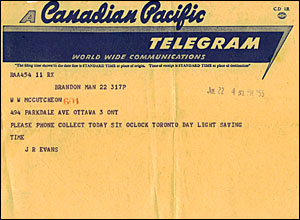
9 February 2006
Telegrams Keep on Ticking
| |

A Canadian Pacific telegram from 1955 is seen in this file
image.
|
The telegram is dead stop long live the telegram.
After more than 150 years, Western Union messages of joy and sorrow officially passed into U.S. history last month, leaving a Canadian
company poised to fill the gap.
"We're looking at expanding into the U.S.," Telegrams Canada founder Colin Stone said.
"You'd think that the telegram might be a dying technology, but actually there is more and more interest in it," he said by
phone from Kingston, where his firm is located. "I mean, would you really send wedding congratulations by email? It has no
impact."
Western Union, established in the 1850s, built its first transcontinental telegraph line in 1861 to send messages coast to coast in the
United States instantly.
"At the time, it was as incredible and astonishing as the computer when it first came out," said history professor Tom Noel,
of the University of Colorado at Denver. "Here you had the magic of the electric force travelling by wire across the country."
Popularity peaked in the 1920s and 1930s, when sending a telegram was cheaper than placing a long-distance telephone call.
People also saved money by using the word "stop" instead of a period to end a sentence because punctuation was extra, while
the word was free.
In Canada, Canadian National Railway and Canadian Pacific Railway offered telegram services, later taken over by AT&T, which
abandoned the business in 1999.
"I collect telegrams and telegraph equipment," Stone, 37, said of his long-time interest in the field. "I
have quite a collection - including a few (telegrams) from the 1800s - and in 2002 I was kind of shocked to learn that there was no
telegram service available in Canada."
Drawing from a computer and marketing background, he formed Telegrams Canada the following year.
"Hand-delivered in 1-2 business days," his Web site, telegrams.ca, reads. "Makes a lasting keepsake for any occasion."
The sender files a message with the company by phone or email and pays by credit card. Telegrams Canada relays the message to a
telegraph or post office in the destination country through an international telegraph system. The message is then printed and
delivered either by mail or courier.
"If someone needs to send a telegram to Italy or Zimbabwe or anywhere else, it usually gets delivered in a few hours," Stone
said, "whereas an air letter may take a few weeks or may never get there at all."
The same transmitting, printing, and delivering process takes place for Canadian destinations as well, although domestic telegram
traffic isn't what it once was.
In 1955, Canadians sent 5 million telegrams, Stone estimated. His business now handles "a couple of hundred a month."
But volume is growing, he said. Users usually discover him on the Internet or in the Yellow Pages of major U.S. and Canadian cities.
Rates start at $26 for Canadian addresses, $46 for overseas.
"I think there will still be a demand for years to come," Stone said. "There are still a lot of people who get a real
kick out of someone knocking on the door and saying, "There's a telegram for you".
|